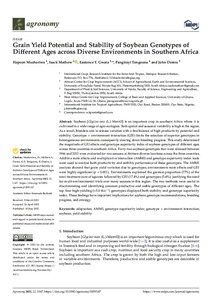| dc.contributor.author | Mushoriwa, H. |
| dc.contributor.author | Mathew, I. |
| dc.contributor.author | Gwata, E.T. |
| dc.contributor.author | Tongoona, P. |
| dc.contributor.author | Derera, J. |
| dc.date.accessioned | 2022-06-08T09:36:23Z |
| dc.date.available | 2022-06-08T09:36:23Z |
| dc.date.issued | 2022 |
| dc.identifier.citation | Mushoriwa, H., Mathew, I., Gwata, E.T., Tongoona, P. & Derera, J. (2022). Grain yield potential and stability of soybean genotypes of different ages across diverse environments in southern Africa. Agronomy, 12(5), 1-11. |
| dc.identifier.issn | 2073-4395 |
| dc.identifier.uri | https://hdl.handle.net/20.500.12478/7497 |
| dc.description.abstract | Soybean [Glycine max (L.) Merrill] is an important crop in southern Africa where it is cultivated in a wide range of agro-ecologies. Both spatial and seasonal variability is high in the region. As a result, breeders aim to release varieties with a fine balance of high productivity potential and stability. Genotype × environment interaction (GEI) limits the selection of superior genotypes in heterogeneous environments consequently slowing down breeding progress. This study determined the magnitude of GEI effects and genotype superiority index of soybean genotypes of different ages across three countries in southern Africa. Forty-two soybean genotypes that were released between 1966 and 2013 were evaluated for two seasons at thirteen diverse locations across the three countries. Additive main effects and multiplicative interaction (AMMI) and genotype superiority index tools were used to analyse both productivity and stability performance of these genotypes. The AMMI analysis showed that grain yield variation due to genotypes, environments main effects and GEI were highly significant (p < 0.001). Environments explained the greatest proportion (77%) of the total treatment sum of squares followed by GEI (17.4%) and genotypes (5.6%), justifying the need for multi-environmental trials over many seasons in this region. The two methods were useful in discriminating and identifying common productive and stable genotypes of different ages. The top four high-yielding (>5.0 tha−1) genotypes displayed both stability and genotype superiority index. These findings have important implications for soybean genotype recommendations, breeding progress, and strategy. |
| dc.format.extent | 1-11 |
| dc.language.iso | en |
| dc.subject | Adaptation |
| dc.subject | Genotypes |
| dc.subject | Genotype Environment Interaction |
| dc.subject | Soybeans |
| dc.subject | Yields |
| dc.title | Grain yield potential and stability of soybean genotypes of different ages across diverse environments in southern Africa |
| dc.type | Journal Article |
| cg.contributor.crp | Grain Legumes |
| cg.contributor.affiliation | International Crops Research Institute for the Semi-Arid Tropics |
| cg.contributor.affiliation | University of KwaZulu-Natal |
| cg.contributor.affiliation | University of Venda |
| cg.contributor.affiliation | University of Ghana |
| cg.contributor.affiliation | International Institute of Tropical Agriculture |
| cg.coverage.region | Africa |
| cg.coverage.region | Southern Africa |
| cg.coverage.country | Malawi |
| cg.coverage.country | Zambia |
| cg.coverage.country | Zimbabwe |
| cg.coverage.hub | Headquarters and Western Africa Hub |
| cg.identifier.bibtexciteid | MUSHORIWA:2022 |
| cg.isijournal | ISI Journal |
| cg.authorship.types | CGIAR and developing country institute |
| cg.iitasubject | Agronomy |
| cg.iitasubject | Food Security |
| cg.iitasubject | Grain Legumes |
| cg.iitasubject | Plant Breeding |
| cg.iitasubject | Plant Production |
| cg.iitasubject | Soybean |
| cg.journal | Agronomy |
| cg.notes | Open Access Journal; Published online: 10 May 2022 |
| cg.accessibilitystatus | Open Access |
| cg.reviewstatus | Peer Review |
| cg.usagerightslicense | Creative Commons Attribution 4.0 (CC BY 0.0) |
| cg.targetaudience | Scientists |
| cg.identifier.doi | https://dx.doi.org/10.3390/agronomy12051147 |
| cg.futureupdate.required | No |
| cg.identifier.issue | 5 |
| cg.identifier.volume | 12 |

